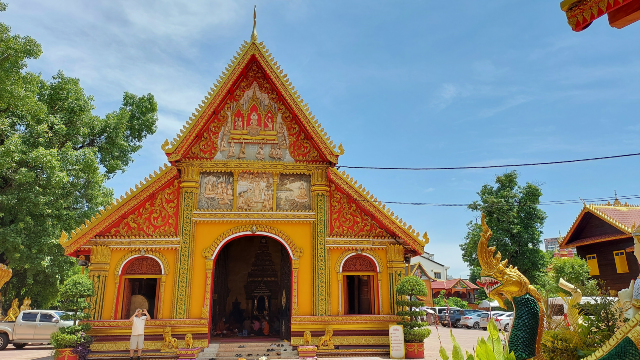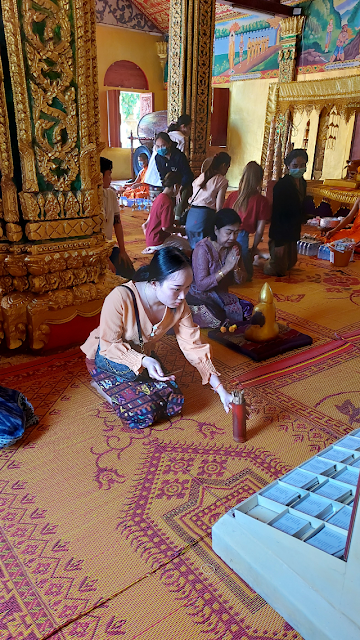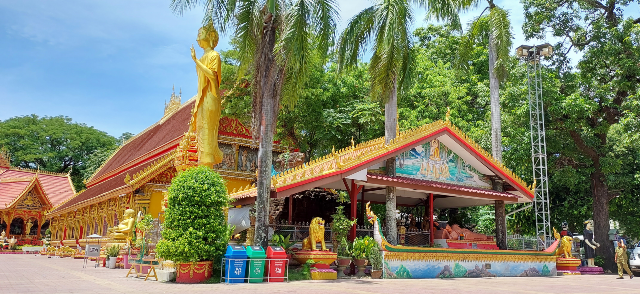One of the very important temples to visit in Vientiane is Wat Si Muang or Simoung. It is known for its central pillar which is the spiritual heart of the city. The central pillar is now located to another place nearby.
Being a sacred temple, people come for peace and blessings.
Legend of the temple:
When
Vientiane was being built, the king decided to erect a city pillar.
While digging a hole for the pillar, underground water gushed out and
would not stop. Taking it as the anger of spirits and to stop the flow
of water, a young pregnant girl named Si Muang, volunteered to jump into
the hole to plug the source of water.
Hundred
days later, the hole filled and the pillar was erected on the ground.
The temple was named Si Muang to honor the brave girl's sacrifice. According to another legend, Si Muang jumped into the hole where the
central pillar was to be placed and was crushed when the pillar was
lowered into the hole. She
is therefore revered as a guardian city spirit, and the temple is known as the
'Mother temple' of Vientiane.
History:
- Like That Luang, this temple too is built on the ruins of a Khmer Hindu temple, though this is the oldest.
- It was built around 12th century making it the oldest pagoda, almost 900 years old.
- the remains of old temple can be seen behind the ordination hall.
- The temple was built by King Setthathirath in 1536 at exactly the place where Si Muang sacrificed her life.
- In 1828, Thais invaded Vientiane and most of the city along with this wat was destroyed.
- The temple has an area of more than 2 hectares and has many other temples around the sim.
- The central pillar in sim may be a stone pillar from this temple or some another Khmer shrine.
- It was rebuilt in 1915 after it was destroyed by Thais after they invaded Vientiane.
entrance gate
view of gate from outside
Near the car park, under the bodhi tree are Buddha images in various mudras.
On the side under the same tree is a big image of Buddha. It is in Na Plok mudra, the Buddha meditating under a canopy of Muchalinda.
Ordination hall or Sim:
The exterior and interior decorations in sim are exquisite. Usually, sim consists of one room but here there are two rooms. The building of sim is stunning with a beautiful gable.
outside view of sim
gable depicting scenes from the life of Buddha
The gable of sim illustrates Buddha sitting in meditative posture or
dhyaan mudra. Below him are seated his disciples with folded hands.
Below the above illustration are three scenes from Buddha's life: first one on the left shows Buddha with his five important disciples, Gautam becomes Buddha and is being blessed by celestial deities, below him are seated kings and nobles on one side and monks on the other. The illustration on right depicts Buddha meditating under a bodhi tree.Entrance to sim is guarded by a pair of golden roaring lions on each side.
Inside of sim:
Front hall:
drum and gong in a corner of room
The sim walls are painted with scenes from the life of Buddha.
carved door at entrance
decorative colorful gong
monk blessing a family
In
contrast to other temples, where the interior is in a combination of
red and gold, the sim in Wat Si Muang is lavishly adorned with pillars
in gold on a background of green. The ceilings are in red and gold.
The outer front room has monks blessing people and tying the sacred thread (Baci) to bring good luck and fortune.
colored friezes on ceiling and painted scenes on Buddha's life
ornamentation on ceiling
 The interior of the temple is lavishly adorned in the usual manner
with carved gold pillars, brightly colored ceiling friezes and painted
scenes from the life of the Buddha.
The interior of the temple is lavishly adorned in the usual manner
with carved gold pillars, brightly colored ceiling friezes and painted
scenes from the life of the Buddha. the central image
The image in the center of sim holds special importance. When Siam invaded Vientiane in 1828, the wat was burnt down along with many other places in the city. Only the central stone seated image survived the disaster.
It is believed that if a woman in her first pregnancy comes and requests Buddha to help, she has no problems with her pregnancy and can easily deliver her baby.
central stone image flanked by two Buddha images
front view of image
Somewhat melted-looking seated stone Buddha which survived the 1828 fire. The stone shows signs of blisters over it.
Emerald Buddha on top of donation box
Spiritual beliefs and practices in wat, girl with Kau Chim oracles, fortune sheets in right of picture
Kau Chim oracles:
These are 78 fortune telling sticks where a person puts a question and the answers are interpreted from the flat sticks.
After
donation money has put in donation box, the sticks called "qian" are
shuffled. The shuffled sticks are dropped back in the container.
The
stick which sticks out the highest is picked up. In front, below the donation box, are fortune papers kept in different sections. The stick which was picked has a number and
corresponding to that number, one finds the fortune written in the section. woman praying
A golden heavy stone statue placed on a pillow or mat is seen specially in this wat. It has the power to grant wishes if one raises it and brings to his forehead three times praying at the same time. Most of its gold color is lost by being handled many times.
Once the wishes are answered, you are supposed to come back with an offering of bananas, flowers, green coconut, candles, joss sticks usually with two of each.
Rear hall:
The rear hall is the worship hall and you see plenty of Buddha images.
The focus in this room does not go to any huge image of Buddha but a column surrounded by Buddha images.
In the center of room, is a column wrapped around by a cloth. The pillar is not placed on a pedestal but seems to go deeper down in the ground.This is the city pillar or lák meuang which is surrounded by many Buddha images. According to some source, it is a part of Shivlinga which belonged to the ruined Khmer temple. Actually, during the reign of Jayavarman VII (1181-1218), Vientiane and its surrounding area was under Khmer control.
the copper colored ceiling with carved wood decorations is very different from the front room
central stone and ceilingcentral stonea very old painting on ceiling
On the sides of sim are seen sema stones. Sema stones are the sacred boundary of sim. Roaring lions guard the entrance.
Ruins of Khmer temple:
Just behind the sim, is a pile of stones which is wrapped by a green cloth at top, probably the shikhar. These are the ruins of an old Khmer Hindu temple.
Laterite blocks with porous surfaces was commonly used as the building material during that time.
Khmer style piece of work
entrance to shrine
The ruins of temple is now revered as a chedi or stupa.
Entrance has Mae Thorani or Mother Earth goddess on one side.
Garuda on the other side
The base of temple is lined by Buddha images
standing Buddha
side view of temple ruins
a spirit house(San Phra Phum)
This is something which is commonly seen not only in Laos but throughout South-east Asia. Some are beautifully made and colored. They are usually made from wood or cement. They look like a smaller version of a temple.
Mostly seen in this region, it is not a Buddhist tradition but is more related to animist practice. People believe that they house any nearby spirits. Offerings are made of drinks, food, fruits, candles etc.
rear view of temple
On the side, is an entrance with many images inside.
statue of Si Muang, patron deity of the city
Locals come and make offerings in front of the image.
We met two young girls who came from Bangalore, I forgot to ask their names, but if, whenever they read this blog, they would know and remember the moment.
Brahma
temple
temple guardian near entrance
dok so faa on top
gable of room and standing Buddha in front
chofaa and gable
Indra




































































